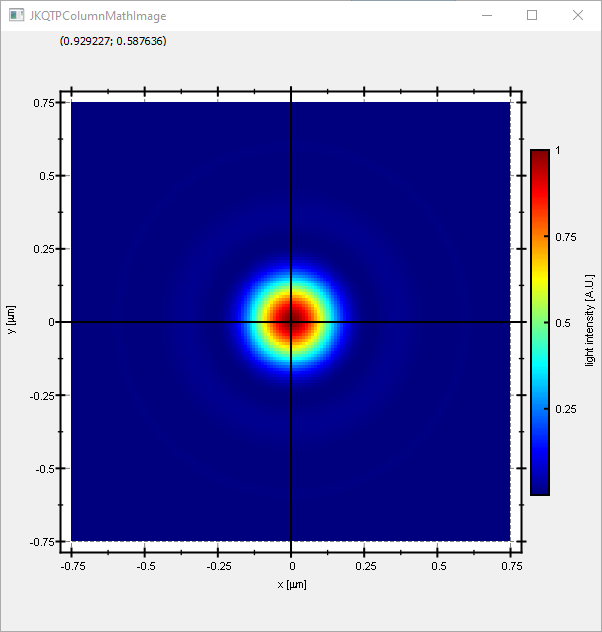mirror of
https://github.com/jkriege2/JKQtPlotter.git
synced 2025-02-19 02:39:26 +08:00
129 lines
6.3 KiB
Markdown
129 lines
6.3 KiB
Markdown
# Example (JKQTPlotter): Simple math image plot, showin a 1-channel CImg image {#JKQTPlotterImagePlotCImg}
|
|
|
|
This project (see `./examples/imageplot_cimg/`) simply creates a JKQTPlotter widget (as a new window) and adds a color-coded image plot of a mathematical function (here the Airy disk). The image is generated as a [CImg](https://cimg.org/) [`cimg_library::CImg<double>`](http://cimg.eu/reference/structcimg__library_1_1CImg.html) image and then copied into a single column of the internal datastore (JKQTPMathImage could be directly used without the internal datastore).
|
|
|
|
To copy the data a special CImg Interface function `JKQTPCopyCImgToColumn()` is used, that copies the data from a [`cimg_library::CImg<double>`](http://cimg.eu/reference/structcimg__library_1_1CImg.html) directly into a column.
|
|
|
|
The function `JKQTPCopyCImgToColumn()` is available from the (non-default) header-only extension from `jkqtplotter/jkqtpinterfacecimg.h`. This header provides facilities to interface JKQTPlotter with CImg. The CImg-binding itself is header-only, and NOT compiled into the JKQtPlotter libraries. Therefore you can simply include the header and use the facilities provided by it.
|
|
|
|
The CMake-build system of JKQtPlotter (and its examples) provides facilities to allow for `find_package(CImg)` to compile against that library.
|
|
If you want to build the CImg-based JKQtPlotter examples (see list above), you either have to ensure that CMake finds CImg by itself (i.e. somewhere in the default search paths, e.g. `CMAKE_INSTALL_PREFIX`), or you can set the CMake variable `CImg_DIR` so it points to the directory of the `CImg.h` file, or before configuring JKQtPlotter.
|
|
|
|
|
|
The source code of the main application is (see [`imageplot_cimg.cpp`](https://github.com/jkriege2/JKQtPlotter/tree/master/examples/imageplot_cimg/imageplot_cimg.cpp):
|
|
```.cpp
|
|
#include <QApplication>
|
|
#include <cmath>
|
|
#include "jkqtplotter/jkqtplotter.h"
|
|
#include "jkqtplotter/graphs/jkqtpscatter.h"
|
|
#include "jkqtplotter/graphs/jkqtpimage.h"
|
|
#include "jkqtplotter/jkqtpinterfacecimg.h"
|
|
#include "CImg.h"
|
|
|
|
#ifndef M_PI
|
|
#define M_PI 3.14159265358979323846
|
|
#endif
|
|
|
|
|
|
int main(int argc, char* argv[])
|
|
{
|
|
QApplication app(argc, argv);
|
|
|
|
JKQTPlotter plot;
|
|
|
|
|
|
// 1. create a plotter window and get a pointer to the internal datastore (for convenience)
|
|
plot.getPlotter()->setUseAntiAliasingForGraphs(true); // nicer (but slower) plotting
|
|
plot.getPlotter()->setUseAntiAliasingForSystem(true); // nicer (but slower) plotting
|
|
plot.getPlotter()->setUseAntiAliasingForText(true); // nicer (but slower) text rendering
|
|
JKQTPDatastore* ds=plot.getDatastore();
|
|
|
|
|
|
// 2. now we create data for the charts (taken from https://commons.wikimedia.org/wiki/File:Energiemix_Deutschland.svg)
|
|
cimg_library::CImg<double> airydisk(150, 150); // CImg<T>-Image for the data
|
|
const double dx=1e-2; // size of a pixel in x-direction [micrometers]
|
|
const double dy=1e-2; // size of a pixel in x-direction [micrometers]
|
|
const double w=static_cast<double>(airydisk.width())*dx;
|
|
const double h=static_cast<double>(airydisk.height())*dy;
|
|
|
|
// 2.1 Parameters for airy disk plot (see https://en.wikipedia.org/wiki/Airy_disk)
|
|
double NA=1.1; // numerical aperture of lens
|
|
double wavelength=488e-3; // wavelength of the light [micrometers]
|
|
|
|
// 2.2 calculate image of airy disk in a row-major array
|
|
double x, y=-h/2.0;
|
|
for (int iy=0; iy<airydisk.height(); iy++ ) {
|
|
x=-w/2.0;
|
|
for (int ix=0; ix<airydisk.width(); ix++ ) {
|
|
const double r=sqrt(x*x+y*y);
|
|
const double v=2.0*M_PI*NA*r/wavelength;
|
|
airydisk(iy,ix) = pow(2.0*j1(v)/v, 2);
|
|
x+=dx;
|
|
}
|
|
y+=dy;
|
|
}
|
|
|
|
|
|
// 3. make data available to JKQTPlotter by adding it to the internal datastore.
|
|
// In this step the contents of one channel of the CImg cimg_library::CImg<double> is copied into a column
|
|
// of the datastore in row-major order
|
|
size_t cAiryDisk=JKQTPCopyCImgToColumn(ds, airydisk, "imagedata");
|
|
|
|
|
|
// 4. create a graph (JKQTPColumnMathImage) with the column created above as data
|
|
// The data is color-coded with the color-palette JKQTPMathImageMATLAB
|
|
// the converted range of data is determined automatically because setAutoImageRange(true)
|
|
JKQTPColumnMathImage* graph=new JKQTPColumnMathImage(&plot);
|
|
graph->setTitle("");
|
|
// image column with the data
|
|
graph->setImageColumn(cAiryDisk);
|
|
// set size of the data (the datastore does not contain this info, as it only manages 1D columns of data and this is used to assume a row-major ordering
|
|
// where does the image start in the plot, given in plot-axis-coordinates (bottom-left corner)
|
|
graph->setX(-w/2.0);
|
|
graph->setY(-h/2.0);
|
|
// width and height of the image in plot-axis-coordinates
|
|
graph->setWidth(w);
|
|
graph->setHeight(h);
|
|
// color-map is "MATLAB"
|
|
graph->setColorPalette(JKQTPMathImageMATLAB);
|
|
// get coordinate axis of color-bar and set its label
|
|
graph->getColorBarRightAxis()->setAxisLabel("light intensity [A.U.]");
|
|
// determine min/max of data automatically and use it to set the range of the color-scale
|
|
graph->setAutoImageRange(true);
|
|
// you can set the color-scale range manually by using:
|
|
// graph->setAutoImageRange(false);
|
|
// graph->setImageMin(0);
|
|
// graph->setImageMax(10);
|
|
|
|
|
|
// 5. add the graphs to the plot, so it is actually displayed
|
|
plot.addGraph(graph);
|
|
|
|
// 6. set axis labels
|
|
plot.getXAxis()->setAxisLabel("x [{\\mu}m]");
|
|
plot.getYAxis()->setAxisLabel("y [{\\mu}m]");
|
|
|
|
// 7. fix axis and plot aspect ratio to 1
|
|
plot.getPlotter()->setMaintainAspectRatio(true);
|
|
plot.getPlotter()->setMaintainAxisAspectRatio(true);
|
|
|
|
// 8 autoscale the plot so the graph is contained
|
|
plot.zoomToFit();
|
|
|
|
// show plotter and make it a decent size
|
|
plot.show();
|
|
plot.resize(600,600);
|
|
plot.setWindowTitle("JKQTPColumnMathImage");
|
|
|
|
|
|
return app.exec();
|
|
}
|
|
|
|
```
|
|
The result looks like this:
|
|
|
|

|
|
|
|
See [`examples/imageplot`](https://github.com/jkriege2/JKQtPlotter/tree/master/examples/imageplot) for a detailed description of the other possibilities that the class JKQTPColumnMathImage (and also JKQTPMathImage) offer with respect to determining how an image is plottet.
|
|
|